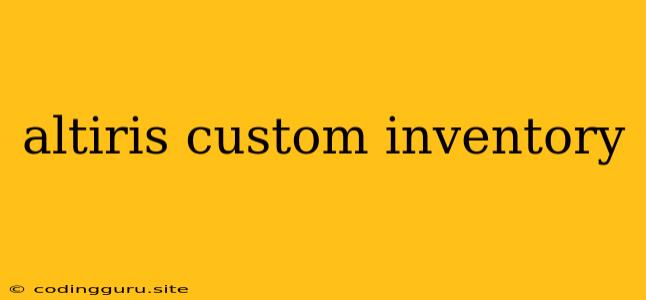Unlocking the Power of Altiris Custom Inventory
Altiris, a powerhouse in system management, offers robust features to streamline your IT operations. One such feature is the Altiris Custom Inventory, which allows you to collect specific data beyond the standard inventory information. But how do you harness its full potential?
Why Use Altiris Custom Inventory?
Imagine needing to gather detailed information about specific applications installed on your systems, like versions, configurations, or even user-specific settings. This is where Altiris Custom Inventory comes in. It provides a powerful way to:
- Tailor your inventory to your needs: Go beyond the standard inventory data and collect information specific to your environment, like software licenses, hardware details, or even custom data points.
- Gain deeper insights: With specific data collected, you can gain a more comprehensive understanding of your IT infrastructure, allowing for better decision-making and resource allocation.
- Simplify reporting and analysis: Create custom reports based on the data you collect, enabling you to identify trends, troubleshoot issues, and optimize your environment.
Custom Inventory: A Step-by-Step Guide
Here's how to set up and use Altiris Custom Inventory effectively:
-
Defining Your Inventory Needs:
- Start by identifying the specific information you need to collect.
- Define the data points you'll be tracking, including their data types (text, numeric, date, etc.) and the systems you want to target.
-
Creating Custom Inventory Rules:
- Altiris Custom Inventory uses rules to define what data to collect. These rules involve:
- Identifying the data source: This could be a registry key, a file, or even a command output.
- Specifying the data extraction method: Choose how to extract the relevant information from the source.
- Defining the data type and name: Assign a clear name and data type to the collected data.
- Altiris Custom Inventory uses rules to define what data to collect. These rules involve:
-
Implementing the Rules:
- Altiris Custom Inventory uses a simple and intuitive interface to create and manage the rules.
- You can test your rules individually to ensure they collect the desired data.
- Once satisfied, deploy the rules to your managed systems.
-
Monitoring and Refining:
- Monitor the data collected by your Altiris Custom Inventory rules regularly.
- Review the accuracy of the collected information and make adjustments to the rules if necessary.
- Use the collected data to create custom reports and dashboards for easy analysis.
Real-World Examples:
- Tracking Software Licenses: Create rules to collect data about installed software licenses, such as license keys, expiry dates, and assigned users. This can help you manage license compliance and avoid potential issues.
- Monitoring System Health: Develop rules to collect performance data from critical systems, such as CPU usage, memory consumption, and disk space. This can help you proactively identify potential bottlenecks and ensure optimal system performance.
- Auditing Security Configuration: Implement rules to collect information about security settings, such as firewall rules, user permissions, and patch levels. This can help you maintain a secure IT environment and identify potential vulnerabilities.
Tips for Success:
- Start Small: Begin with a few critical data points and gradually expand your Altiris Custom Inventory as needed.
- Document Everything: Create clear documentation for your inventory rules, data definitions, and reporting mechanisms.
- Maintain Regular Reviews: Regularly review your Altiris Custom Inventory rules and data to ensure accuracy and effectiveness.
- Leverage Custom Reports: Explore the reporting capabilities of Altiris Custom Inventory to create informative dashboards and visualizations based on your collected data.
Conclusion:
Altiris Custom Inventory is a powerful tool for gaining deeper insights into your IT infrastructure. By leveraging its features, you can tailor your inventory data to meet specific needs, gain actionable insights, and make informed decisions to optimize your environment. Remember to start small, document your setup, and maintain regular reviews for a successful and impactful Altiris Custom Inventory strategy.
